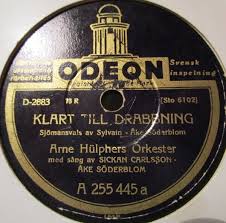
Daily Dose Of Jazz…
Arne Gunnar Valter Hülphers was born April 4, 1904 in Trollhättan, Sweden. Early in his career he played at the club Felix-Kronprinsen from 1924 to 1927, and played in dance bands into the early 1930s.
He founded his own ensemble in 1934 which became one of Sweden’s most important jazz big bands. They toured Europe and recorded until 1940. Sidemen in his group included Miff Görling, Zilas Görling, and Thore Jederby.
Later in his career, he concentrated more on popular musical styles; he led an orchestra in which Fred Bertelmann played. Pianist and bandleader Arne Hülphers died on July 24, 1978 in Norrköping Municipality, Sweden.
More Posts: bandleader,history,instrumental,jazz,music,piano
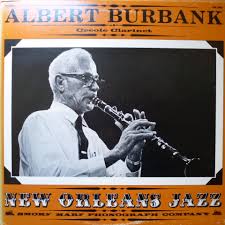
Daily Dose Of Jazz…
Albert Burbank was born March 25, 1902 in New Orleans, Louisiana and was taught clarinet by Lorenzo Tio, one of that city’s most famous clarinet players. Staying in the New Orleans area throughout the 1920s, he played wherever his services were needed. During the 1930s, he worked with Kid Milton’s band but was drafted into the US Navy during World War II.
Upon demobilization, he worked internationally with the bands of Paul Barbarin and Kid Ory. Returning to New Orleans he played with several of the well-known jazz and brass bands in the city. He was regularly seen at Preservation Hall and toured Australia with a band made up of Preservation Hall musicians.
In 1975 Albertsuffered a stroke but continued playing until his death on August 15, 1976. Many of his recordings of broadcast performances with Kid Ory’s band at San Francisco’s Hangover Club, have been issued on the Danish Storyville label, and some with trombonist Bill Matthews appear on Southland.
Burbank would go on to record with Wooden Joe Nicholas, Herb Morand, Kid Clayton, Paul Barbarin, Percy Humphrey, and Jimmy Archey.
Clarinetist Albert Burbank died on August 15, 1976 in his hometown.More Posts: clarinet,history,instrumental,jazz,music
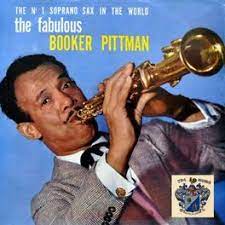
Daily Dose Of Jazz…
Booker Pittman was born on March 3, 1909 in Fairmount Heights, Maryland, was the son of Portia Pittman and a grandson of Booker T. Washington. He became an accomplished jazz clarinetist and played with greats like Louis Armstrong and Count Basie in the US and Europe in the 1920s and 1930s.
Leaving the States for the first time in 1933, he went with Lucky Millinder’s orchestra to France and stayed there for four years. During that period, he met a Brazilian musician named Romeo Silva, who took him on a tour of Brazil along with other musicians. They sailed to Bahia aboard the Siqueira Campos.
In 1937, Booker moved to Brazil, where he was known by the nickname “Buca“, and continued his musical career there, playing at the Urca Casino. He lived in Copacabana and befriended Jorge Guinle and Pixinguinha. He also played in Argentina and other countries.
He performed and recorded with his singer/actress stepdaughter Eliana Pittman. On October 19, 1969 clarinetist and saxophonist Booker Pittman, sometimes spelled Pitman, transitioned in his home in the São Paulo quarter of Vila Nova Conceição of laryngeal cancer at the age of 60. On behest of his wife Ofélia he was transferred to Rio de Janeiro and there laid to rest at the Cemitério São João Batista in the quarter of Botafogo.
More Posts: clarinet,history,instrumental,jazz,music,saxophone
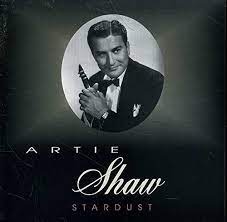
Daily Dose Of Jazz…
Lennie Hayton was born Leonard George Hayton on February 14, 1908 in New York City into a Jewish family. He developed a penchant for the piano when he was six years old, showing unusual interest in the early classics from the rolls of the family player piano. His parents disliked jazz, so it wasn’t until he was sixteen that he really discovered it. He left high school to become pianist with the Broadway Hotel Orchestra of Cass Hagen, a boyhood friend.
While playing at the Park Central, Hayton was heard by Paul Whiteman and immediately engaged by him in 1928 as second pianist, playing piano and celeste as well as acting as a part-time arranger. Whilst with the orchestra, he played with Frankie Trumbauer, Bix Beiderbecke, Red Nichols, Joe Venuti and became friendly with Bing Crosby, then a member of The Rhythm Boys. However, by 1930 due to the impact of radio on audiences, Whiteman released ten members of the band. Hayton then joined the Charles Previn Orchestra.
Rejoining Crosby he embarked on a cross-country tour, landing in Hollywood. 1932 saw Hayton leading an orchestra for his first recordings of Cabin in the Cotton, Love Me Tonight, Brother, Can You Spare a Dime? and Some of These Days all became Bing hits. The following year , Hayton became the musical director for the Chesterfield radio series Music That Satisfies which again featured Crosby and ran for 13 weeks.
His involvement with Crosby continued as musical director for the singer’s 1933 film Going Hollywood at Metro-Goldwyn-Mayer. This led to a major career for Hayton who continued to work with Crosby and became a musical director for MGM and guided it through its prime years as foremost producer of movie musicals. Up until his retirement from the post in 1953, Lennie racked up four Oscar nominations: The Harvey Girls, The Pirate, Singin’ in the Rain and Star! He won the Academy Award for music for On the Town and Hello, Dolly!.
He arranged for Frank Sinatra, composed Apple Blossoms with Joe Venuti, Frankie Trumbauer, and Eddie Lang, and his other compositions included Flying Fingers, The Stage is Set, Mood Hollywood with Jimmy Dorsey, and Midnight Mood. Hayton also co-arranged the Hoagy Carmichael composition Stardust with Artie Shaw for Bluebird Records.
His first marriage to Helen Maude Gifford ended in her death in 1943. Three years later he married Lena Horne whom he met on the MGM lot. Throughout the marriage, Hayton also acted as Horne’s music director. Facing the stresses and pressures of an interracial relationship, they had a tumultuous marriage, first based upon her desire to advance her career and cross the color-line in show business, but she had learned to love him very much.
Pianist, composer, conductor and arranger Lennie Hayton, whose trademark was a captain’s hat worn at a rakish angle, died of a heart attack while separated from Horne, in Palm Springs, California on April 24, 1971.
More Posts: arranger,composer,conductor,history,instrumental,jazz,music,piano
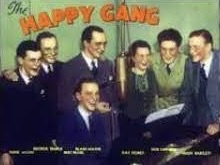
Daily Dose Of Jazz…
Bert Niosi was born on February 10, 1909 in London, Ontario, Canada into a family of musicians, having two brothers who became musicians. As a teenager he briefly played clarinet with Guy Lombardo in Cleveland, Ohio.
Proficient on several instruments he played clarinet, flute, saxophone, trombone, and trumpet and formed a dance band in 1931. This began a long association with the Palais Royale dance hall in Toronto, Canada which lasted until 1950.
His orchestra, and a smaller group made up of some of its members, was broadcast frequently on CBC Radio. Bert played alto saxophone and clarinet in the small band. He was also a member of CBC radio’s The Happy Gang musical series from 1952 to 1959.
Alto saxophone, clarinetist and bandleader Bert Niosi, known as Canada’s King of Swing, died in Toronto, Canada on August 3, 1987.
More Posts: bandleader,clarinet,history,instrumental,jazz,music,saxophone




